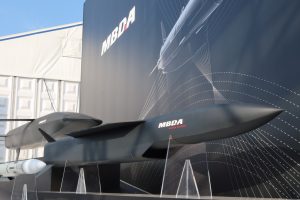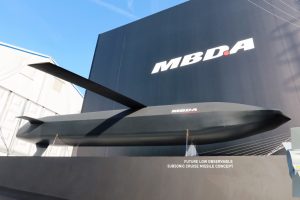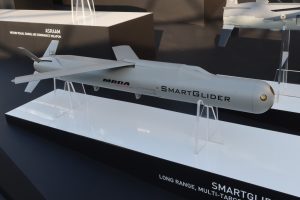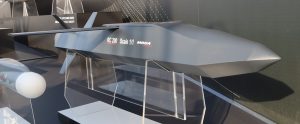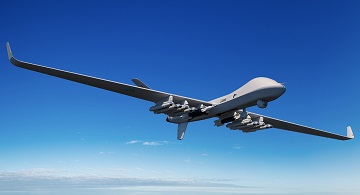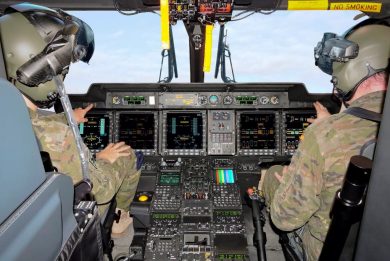
MBDA provides more details on its future air-to-ground effectors and possible international cooperation
The Ukrainian conflict has shown the importance of numbers, quantity being a quality in itself when numerous targets must be hit for long periods. However, some high-tech/high-cost systems are key in disrupting enemy assets, such as air defence ones, therefore a mix of effectors is needed.
This is the path followed by MBDA in the concept study for its unmanned effectors aimed at the Franco-German-Spanish FCAS/SCAF programme, unveiled in 2017 at Le Bourget with more details provided during the Paris Air Show 2019, and highlighted again at Farnborough International Air Show 2022, where European 6th generation air combat systems took the floor. Some more information and operational background were provided at FIAS 2022.
The development of the new family of effectors is carried out on company funds, with some financial support from the French Directorate General of Armaments, DGA in short.
Studies have continued to identify the real needs, which showed two contrasting requirements, one for high-end solutions when key targets must be neutralised and one for low-cost solutions, which can be produced in great numbers, when multiple-targets attrition operations must be carried on.
The FC/ASW solution is definitely the high-end one. This will not be a weapon for general use but rather one capable to send a political signal against strategic targets such as i.e. NBC facilities, allowing to neutralise them with minimal friendly losses. Two weapons are being developed, one supersonic (originally born for anti-ship missions), mostly aimed at deep strike penetration, and one subsonic. The latter will become the successor of the SCALP/Storm Shadow currently in use and will be capable to destroy hardened and buried targets of strategic importance.
According to available information France launched in operation over 500 SCALP (Système de Croisière conventionnel Autonome Longue Portée) long range cruise missiles, fitted with a BROACH (Bomb Royal Ordnance Augmented CHarge) warhead purposely designed to neutralise buried targets. However only 10% of the targets needed such an effector, as the remaining 90% could be destroyed using a different type of warhead. Normal infrastructures can easily be dealt with standard blast warheads which destructive power is proportional to the amount of explosive; a Mk 84 2,000 lb bomb containing around 400 kg of high explosive and generating a huge amount of fragments, fitted with a smart fuse would do the job, hence a warhead with similar capabilities would be sufficient when installed on a missile, helping in reducing cost and increase producibility.
While the FC/ASW will become the future high-end missile for both France and Great Britain, replacing current cruise missiles aimed at naval and land targets, and will be used as enablers helping to perform the overall mission, cheaper solutions must be developed to deal with day after day saturation attacks.
This is where the Smart Glider comes into play. In the foreseeable future flexibility will become a must; according to statistics, in the Gulf war 80% of the missions were carried out against pre-planned targets, while 20% were against targets of opportunity, however today the military consider that this percentage will be the opposite. This means that future weapons should be able to be redirected against the priority target and should be fitted with a multirole warhead capable to deal with many types of targets. The Smart Glider, the name showing the fact that it is fitted with a pair of wings that open following the launch, is an air-launched gliding weapon fitted with a treble navigation system, GNSS, semi-active laser for surgical strikes, and Image Infrared (IIR), the latter derived from the system used on Storm Shadows. Considering the quality of today satellite images, this can be programmed in a matter of seconds, the processing capability being probably fitted into the launcher, the target being identified by a pod or a drone. According to MBDA the specific software is already running at laboratory level. The warhead will be a derivative of the BANG (Bombe Aéronavale de Nouvelle Génération) developed in the late 1990s and used on MK 81 free fall bombs; this has a kinetic energy penetrator and high energy explosive generating blast and fragments. Depending on the release altitude the Smart Glider will be capable to reach targets up to 100 km distance.
To provide a system with same footprint (but probably a slightly higher weight) and increased range MBDA is developing the Smart Cruiser, which is fitted with a turbojet engine. Both engine and fuel will take part of the weight, hence the warhead weight, estimated at around 80 kg, will have to be reduced. Quite probably the penetration capacity will have to be sacrificed, the company aiming at keeping the warhead as big and as flexible as possible. The Smart Cruiser will also be fitted with a data link that will allow the weapon to talk to the launcher for possible updates on targets; the higher manoeuvrability provided by the engine will also allow swarming attacks, hence the link will also permit the weapons on their way to their target to “talk” among them in order to coordinate the attack- To that end EDR On-Line understood that Artificial Intelligence algorithms will be added, probably in a spiral evolution of the system.
Those “Smart” weapons will be fitted on a hexo-launcher, allowing an aircraft to carry 12 of them, thus providing the pilot and mission planners at higher levels with the capacity to hit multiple targets.
However, to open an attack corridor without using high-end systems something else had to be invented. Designed to cope with air defence systems the Remote Carriers designed by MBDA will come in two sizes, small (RC100) and large (RC200). To increase the attacking swarm survivability the first step is the development of an Electronic Warfare Remote Carrier capable to disrupt neural enemy defences, The RC100 EW, which dimensions are close to those of the Smart Glider, should be a sort of SPEAR-EW carrying out scout missions, but it will however retrain a small warhead to provide it with some kill capabilities should the need arise. The RC200 will be bigger and with a longer range and be capable to scout a larger corridor ahead of the formation. Its dimensions will be roughly twice those of the Smart Cruiser and it will be also used in an attack configuration as a sort of mini-FC/AWS against industrial facilities such as oil refineries and other. EDR On-Line understood that the Remote Carrier programme is still on paper and is the one that is struggling the most to be financed.
Although related to the Franco-German-Spanish FCAS/SCAF programme most of those systems can find a place on 5th and 4th generation aircraft; these will probably allow exploiting only part of their capabilities, however they will certainly increase the effectiveness and lethality of those platforms, awaiting the advent of 6th generation aircraft and of the overall combat system, which is a much more comprehensive solution.
With the French DGA pushing on those developments, first systems should be available in the early 2030s, the fact that the Rafale deal with the United Arab Emirates contains some of those elements might allow accelerating their development. A two-year concept phase should lead to an evaluation step, and to the launch of a common French-UAE programme in this domain.
Photos by P. Valpolini

